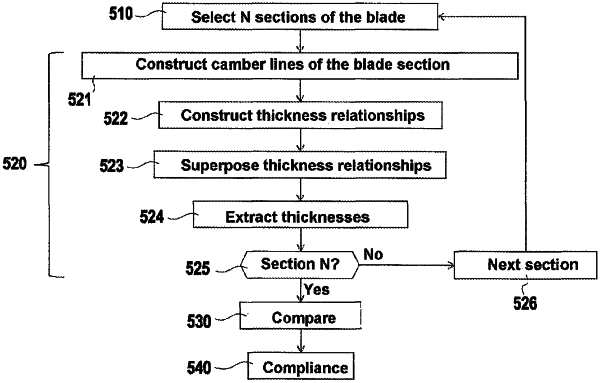| CPC B29D 99/0025 (2013.01) [B23P 15/02 (2013.01); G05D 5/02 (2013.01); F01D 5/141 (2013.01); F05D 2230/18 (2013.01); Y10T 29/49336 (2015.01); Y10T 29/49771 (2015.01)] | 2 Claims |

|
1. A verification method for verifying whether the aerodynamic profile of a real blade for an aircraft turbine engine complies with a theoretical blade, the method comprising:
for a plurality of sections of the real blade, determining a thickness of the real blade and a thickness of the corresponding theoretical blade at a plurality of points along a camber line of the corresponding blade, where thickness is the dimension of the blade extending perpendicularly to the camber line at each point of the camber line;
comparing the thickness of the real blade with the thickness of the theoretical blade for each point of the camber line of each section; and
determining whether the aerodynamic profile of the real blade is in compliance from the result of the comparison of each point of the camber line of each section of the real blade with the theoretical blade;
wherein, for each section, a thickness of the real blade and a thickness of the corresponding theoretical blade for a plurality of points along a camber line of the corresponding blade are determined by:
constructing a camber line of the theoretical blade and constructing a camber line of the real blade;
constructing a relationship for the thickness of the theoretical blade and constructing a relationship for the thickness of the real blade, the thickness relationship of a blade corresponding to the curve plotting the thickness of the blade as a function of curvilinear length along the camber line from a leading edge of the blade to a trailing edge of the blade;
superposing the thickness relationship of the real blade on the thickness relationship of the theoretical blade by using a least-squares superposition function; and
extracting the leading-edge and trailing-edge thicknesses of the real blade at the blade section, the leading-edge and the trailing-edge thicknesses of the real blade being extracted by determining the values on the thickness relationship of the real blade that correspond respectively to the predetermined positions of a leading edge point and of a trailing edge point on the theoretical blade,
the least-squares superposition function corresponding to the following equation:
S(x)=min ΣReal ThicknessX−Theoretical ThicknessX
where “Real Thicknessx” is the thickness of the real blade at a position x along the camber line of the real blade, “Theoretical Thicknessx” is the thickness of the theoretical blade at the same position x along the camber line of the theoretical blade, “min” is a minimum function, and S(x) is a difference for each position x along the camber line.
|